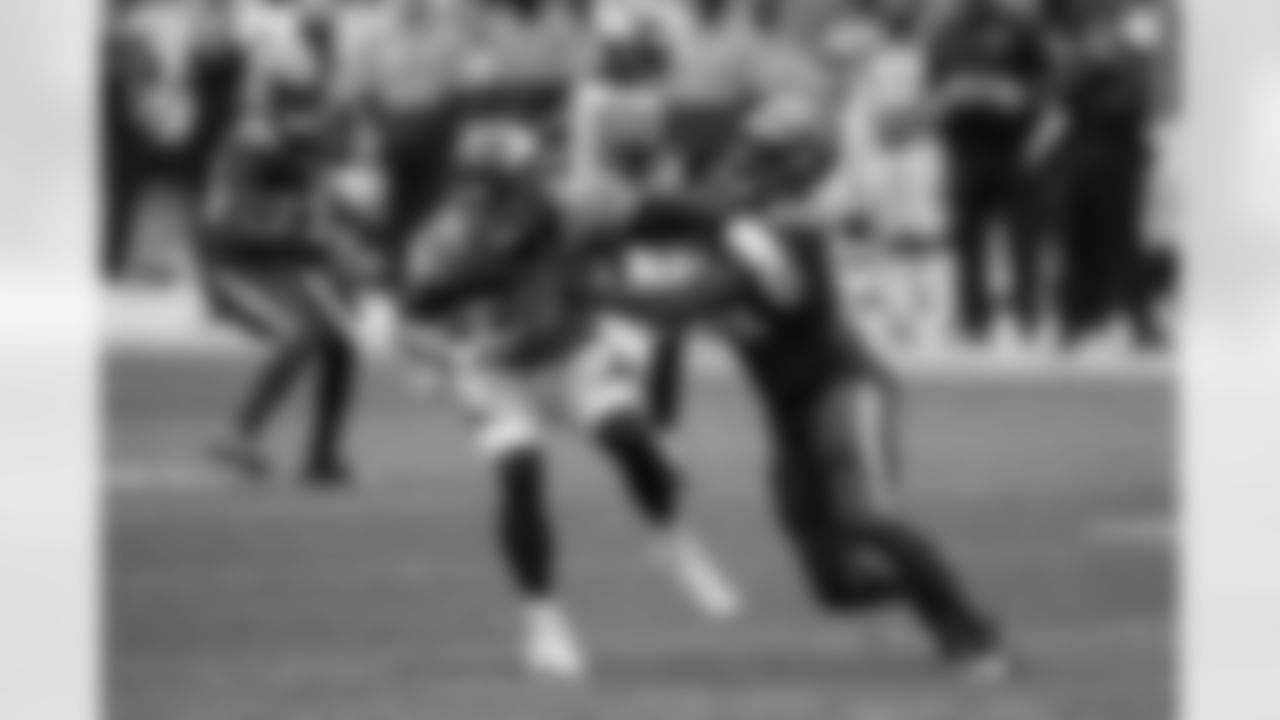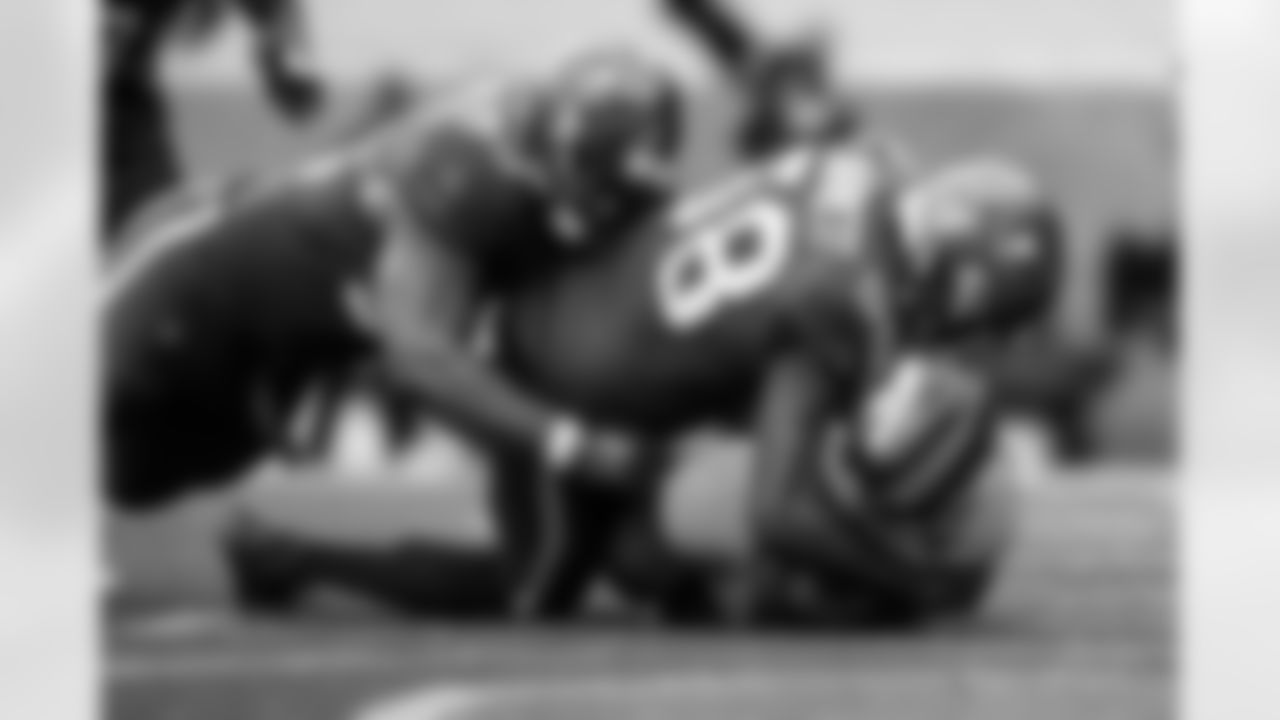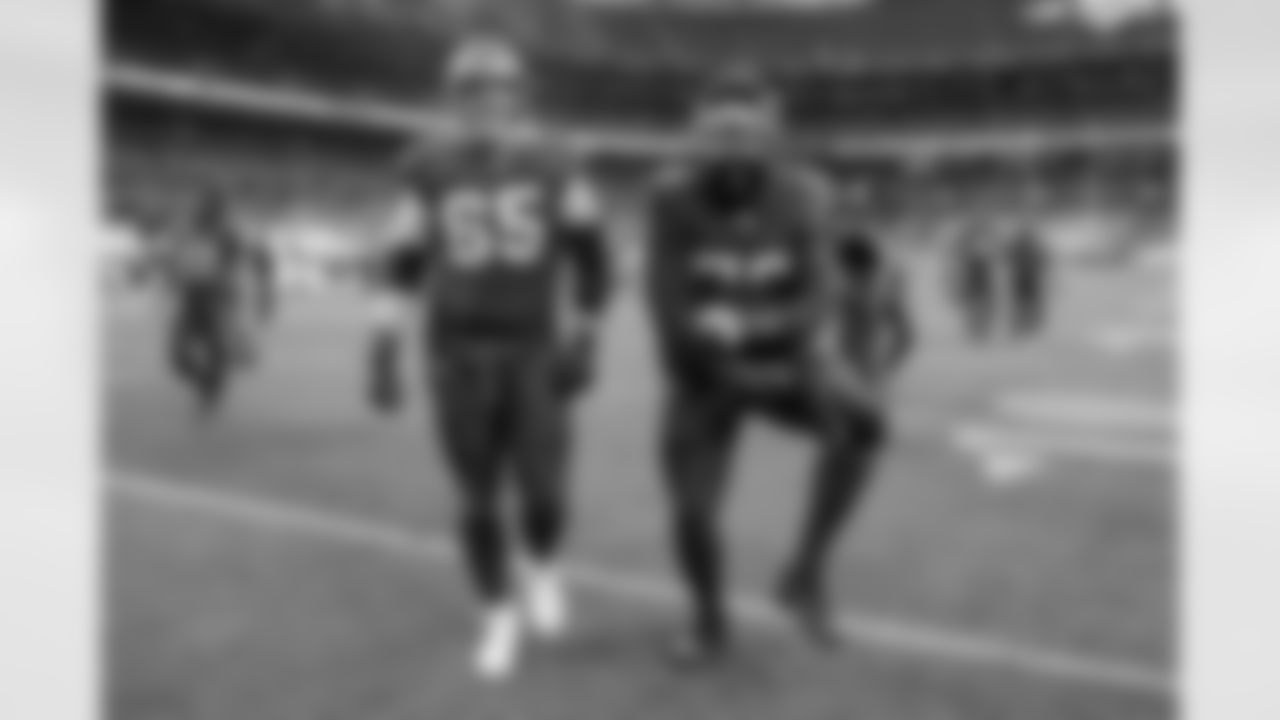If you watched Tampa Bay's 28-10 win over the Broncos in Denver on Sunday, your eyeballs probably led you to believe that the Buccaneers were particularly blitz-happy all afternoon. Your eyeballs were right.
According to the NFL's Next Gen stats, Tampa Bay Defensive Coordinator Todd Bowles dialed up some sort of blitz – that is, more than four players rushing the quarterback – on more than half of the dropbacks made by Denver quarterbacks Jeff Driskel and Brett Rypien. Actually, it was exactly 60% – five or more rushers coming at the QBs on 27 of their 45 attempts to throw the ball.
Bowles wasn't content to just bring one extra rusher on each blitz, either. Of their 27 blitzes, the Buccaneers brought five on 17 of them, but also mixed in nine plays in which six defenders tried to invade the backfield. Bowles even mixed in a seven-man blitz on one play. (It didn't work but the resulting completion only got seven yards.)
The best thing about all of Bowles' blitzing on Sunday was that it worked. The Next Gen stats database says that the Buccaneers pressured the quarterback on 12 of those 27 blitzes. The five-man rushes had a pressure rate of 41.2% of the plays and resulted in four sacks; the six-man rushes had a pressure rate of 55.6% and also resulted in one sack. For the record, the Buccaneers also got one sack and six QB pressures (37.5% pressure rate) on the plays on which they only brought four.
View the top photos of Tampa Bay's Week 3 matchup against Denver. .

DENVER, CO - SEPTEMBER 27, 2020 - Helmet before the game between the Tampa Bay Buccaneers and Denver Broncos at Empower Field at Mile High. The Buccaneers won the game, 28-10. Photo By Kyle Zedaker/Tampa Bay Buccaneers


DENVER, CO - SEPTEMBER 27, 2020 - Pewter uniform before the game between the Tampa Bay Buccaneers and Denver Broncos at Empower Field at Mile High. The Buccaneers won the game, 28-10. Photo By Kyle Zedaker/Tampa Bay Buccaneers

DENVER, CO - SEPTEMBER 27, 2020 - Pewter uniform before the game between the Tampa Bay Buccaneers and Denver Broncos at Empower Field at Mile High. The Buccaneers won the game, 28-10. Photo By Kyle Zedaker/Tampa Bay Buccaneers

DENVER, CO - SEPTEMBER 27, 2020 - Pewter pants before the game between the Tampa Bay Buccaneers and Denver Broncos at Empower Field at Mile High. The Buccaneers won the game, 28-10. Photo By Kyle Zedaker/Tampa Bay Buccaneers

DENVER, CO - SEPTEMBER 27, 2020 - Outside Linebacker Jason Pierre-Paul #90 of the Tampa Bay Buccaneers before the game between the Tampa Bay Buccaneers and Denver Broncos at Empower Field at Mile High. The Buccaneers won the game, 28-10. Photo By Kyle Zedaker/Tampa Bay Buccaneers

DENVER, CO - SEPTEMBER 27, 2020 - Center Ryan Jensen #66 of the Tampa Bay Buccaneers before the game between the Tampa Bay Buccaneers and Denver Broncos at Empower Field at Mile High. The Buccaneers won the game, 28-10. Photo By Kyle Zedaker/Tampa Bay Buccaneers

DENVER, CO - SEPTEMBER 27, 2020 - Outside Linebacker Shaquil Barrett #58 of the Tampa Bay Buccaneers before the game between the Tampa Bay Buccaneers and Denver Broncos at Empower Field at Mile High. The Buccaneers won the game, 28-10. Photo By Kyle Zedaker/Tampa Bay Buccaneers

DENVER, CO - SEPTEMBER 27, 2020 - Cornerback Carlton Davis #24 and Safety Jordan Whitehead #33 of the Tampa Bay Buccaneers before the game between the Tampa Bay Buccaneers and Denver Broncos at Empower Field at Mile High. The Buccaneers won the game, 28-10. Photo By Kyle Zedaker/Tampa Bay Buccaneers

DENVER, CO - SEPTEMBER 27, 2020 - Former Tampa Bay Buccaneer Demar Dotson chats with Guard Alex Cappa #65 and Guard Ali Marpet #74 of the Tampa Bay Buccaneers before the game between the Tampa Bay Buccaneers and Denver Broncos at Empower Field at Mile High. The Buccaneers won the game, 28-10. Photo By Kyle Zedaker/Tampa Bay Buccaneers

DENVER, CO - SEPTEMBER 27, 2020 - Cornerback Sean Murphy-Bunting #23 of the Tampa Bay Buccaneers before the game between the Tampa Bay Buccaneers and Denver Broncos at Empower Field at Mile High. The Buccaneers won the game, 28-10. Photo By Kyle Zedaker/Tampa Bay Buccaneers

DENVER, CO - SEPTEMBER 27, 2020 - Wide Receiver Tyler Johnson #18 of the Tampa Bay Buccaneers before the game between the Tampa Bay Buccaneers and Denver Broncos at Empower Field at Mile High. The Buccaneers won the game, 28-10. Photo By Kyle Zedaker/Tampa Bay Buccaneers

DENVER, CO - SEPTEMBER 27, 2020 - Wide Receiver Chris Godwin #14 of the Tampa Bay Buccaneers before the game between the Tampa Bay Buccaneers and Denver Broncos at Empower Field at Mile High. The Buccaneers won the game, 28-10. Photo By Kyle Zedaker/Tampa Bay Buccaneers

DENVER, CO - SEPTEMBER 27, 2020 - Safety Antoine Winfield Jr. #31 of the Tampa Bay Buccaneers before the game between the Tampa Bay Buccaneers and Denver Broncos at Empower Field at Mile High. The Buccaneers won the game, 28-10. Photo By Kyle Zedaker/Tampa Bay Buccaneers

DENVER, CO - SEPTEMBER 27, 2020 - Helmets before the game between the Tampa Bay Buccaneers and Denver Broncos at Empower Field at Mile High. The Buccaneers won the game, 28-10. Photo By Kyle Zedaker/Tampa Bay Buccaneers

DENVER, CO - SEPTEMBER 27, 2020 - Tight End Rob Gronkowski #87 of the Tampa Bay Buccaneers before the game between the Tampa Bay Buccaneers and Denver Broncos at Empower Field at Mile High. The Buccaneers won the game, 28-10. Photo By Kyle Zedaker/Tampa Bay Buccaneers

DENVER, CO - SEPTEMBER 27, 2020 - Buccaneers fans among fan cutouts before the game between the Tampa Bay Buccaneers and Denver Broncos at Empower Field at Mile High. The Buccaneers won the game, 28-10. Photo By Kyle Zedaker/Tampa Bay Buccaneers

DENVER, CO - SEPTEMBER 27, 2020 - Punter Bradley Pinion #8 of the Tampa Bay Buccaneers before the game between the Tampa Bay Buccaneers and Denver Broncos at Empower Field at Mile High. The Buccaneers won the game, 28-10. Photo By Kyle Zedaker/Tampa Bay Buccaneers

DENVER, CO - SEPTEMBER 27, 2020 - Long Snapper Zach Triner #97 of the Tampa Bay Buccaneers before the game between the Tampa Bay Buccaneers and Denver Broncos at Empower Field at Mile High. The Buccaneers won the game, 28-10. Photo By Kyle Zedaker/Tampa Bay Buccaneers

DENVER, CO - SEPTEMBER 27, 2020 - Inside Linebacker Devin White #45 of the Tampa Bay Buccaneers before the game between the Tampa Bay Buccaneers and Denver Broncos at Empower Field at Mile High. The Buccaneers won the game, 28-10. Photo By Kyle Zedaker/Tampa Bay Buccaneers

DENVER, CO - SEPTEMBER 27, 2020 - Wide Receiver Mike Evans #13 of the Tampa Bay Buccaneers before the game between the Tampa Bay Buccaneers and Denver Broncos at Empower Field at Mile High. The Buccaneers won the game, 28-10. Photo By Kyle Zedaker/Tampa Bay Buccaneers

DENVER, CO - SEPTEMBER 27, 2020 - Head Coach Bruce Arians of the Tampa Bay Buccaneers before the game between the Tampa Bay Buccaneers and Denver Broncos at Empower Field at Mile High. The Buccaneers won the game, 28-10. Photo By Kyle Zedaker/Tampa Bay Buccaneers

DENVER, CO - SEPTEMBER 27, 2020 - Wide Receiver Scotty Miller #10 of the Tampa Bay Buccaneers before the game between the Tampa Bay Buccaneers and Denver Broncos at Empower Field at Mile High. The Buccaneers won the game, 28-10. Photo By Kyle Zedaker/Tampa Bay Buccaneers

DENVER, CO - SEPTEMBER 27, 2020 - Wide Receiver Scotty Miller #10, Wide Receiver Jaydon Mickens #85, Cornerback Sean Murphy-Bunting #23, and Safety Antoine Winfield Jr. #31 of the Tampa Bay Buccaneers before the game between the Tampa Bay Buccaneers and Denver Broncos at Empower Field at Mile High. The Buccaneers won the game, 28-10. Photo By Kyle Zedaker/Tampa Bay Buccaneers

DENVER, CO - SEPTEMBER 27, 2020 - Quarterback Tom Brady #12 of the Tampa Bay Buccaneers before the game between the Tampa Bay Buccaneers and Denver Broncos at Empower Field at Mile High. The Buccaneers won the game, 28-10. Photo By Kyle Zedaker/Tampa Bay Buccaneers

DENVER, CO - SEPTEMBER 27, 2020 - Running Back Kenjon Barner #44 of the Tampa Bay Buccaneers before the game between the Tampa Bay Buccaneers and Denver Broncos at Empower Field at Mile High. The Buccaneers won the game, 28-10. Photo By Kyle Zedaker/Tampa Bay Buccaneers

DENVER, CO - SEPTEMBER 27, 2020 - Cornerback Sean Murphy-Bunting #23 and Safety Antoine Winfield Jr. #31 of the Tampa Bay Buccaneers before the game between the Tampa Bay Buccaneers and Denver Broncos at Empower Field at Mile High. The Buccaneers won the game, 28-10. Photo By Kyle Zedaker/Tampa Bay Buccaneers

DENVER, CO - SEPTEMBER 27, 2020 - Kicker Ryan Succop #3, Punter Bradley Pinion #8, and Long Snapper Zach Triner #97 of the Tampa Bay Buccaneers before the game between the Tampa Bay Buccaneers and Denver Broncos at Empower Field at Mile High. The Buccaneers won the game, 28-10. Photo By Kyle Zedaker/Tampa Bay Buccaneers

DENVER, CO - SEPTEMBER 27, 2020 - Wide Receiver Mike Evans #13, Inside Linebacker Devin White #45, and Safety Andrew Adams #26 of the Tampa Bay Buccaneers before the game between the Tampa Bay Buccaneers and Denver Broncos at Empower Field at Mile High. The Buccaneers won the game, 28-10. Photo By Kyle Zedaker/Tampa Bay Buccaneers

DENVER, CO - SEPTEMBER 27, 2020 - Inside Linebacker Devin White #45 of the Tampa Bay Buccaneers before the game between the Tampa Bay Buccaneers and Denver Broncos at Empower Field at Mile High. The Buccaneers won the game, 28-10. Photo By Kyle Zedaker/Tampa Bay Buccaneers

DENVER, CO - SEPTEMBER 27, 2020 - Safety Mike Edwards #32 of the Tampa Bay Buccaneers before the game between the Tampa Bay Buccaneers and Denver Broncos at Empower Field at Mile High. The Buccaneers won the game, 28-10. Photo By Kyle Zedaker/Tampa Bay Buccaneers

DENVER, CO - SEPTEMBER 27, 2020 - Wide Receiver Tyler Johnson #18 of the Tampa Bay Buccaneers before the game between the Tampa Bay Buccaneers and Denver Broncos at Empower Field at Mile High. The Buccaneers won the game, 28-10. Photo By Kyle Zedaker/Tampa Bay Buccaneers

DENVER, CO - SEPTEMBER 27, 2020 - Wide Receiver Jaydon Mickens #85 of the Tampa Bay Buccaneers before the game between the Tampa Bay Buccaneers and Denver Broncos at Empower Field at Mile High. The Buccaneers won the game, 28-10. Photo By Kyle Zedaker/Tampa Bay Buccaneers

DENVER, CO - SEPTEMBER 27, 2020 - Running Back Ronald Jones II #27 of the Tampa Bay Buccaneers before the game between the Tampa Bay Buccaneers and Denver Broncos at Empower Field at Mile High. The Buccaneers won the game, 28-10. Photo By Kyle Zedaker/Tampa Bay Buccaneers

DENVER, CO - SEPTEMBER 27, 2020 - Guard Ali Marpet #74 of the Tampa Bay Buccaneers during the game between the Tampa Bay Buccaneers and Denver Broncos at Empower Field at Mile High. The Buccaneers won 28-10. Photo By Tori Richman/Tampa Bay Buccaneers


DENVER, CO - SEPTEMBER 27, 2020 - Inside Linebacker Devin White #45 and Defensive Tackle Vita Vea #50 of the Tampa Bay Buccaneers before the game between the Tampa Bay Buccaneers and Denver Broncos at Empower Field at Mile High. The Buccaneers won the game, 28-10. Photo By Kyle Zedaker/Tampa Bay Buccaneers

DENVER, CO - SEPTEMBER 27, 2020 - Quarterback Tom Brady #12 of the Tampa Bay Buccaneers during the game between the Tampa Bay Buccaneers and Denver Broncos at Empower Field at Mile High. The Buccaneers won 28-10. Photo By Tori Richman/Tampa Bay Buccaneers

DENVER, CO - SEPTEMBER 27, 2020 - Cornerback Jamel Dean #35 and Quarterback Tom Brady #12 of the Tampa Bay Buccaneers before the game between the Tampa Bay Buccaneers and Denver Broncos at Empower Field at Mile High. The Buccaneers won the game, 28-10. Photo By Kyle Zedaker/Tampa Bay Buccaneers

DENVER, CO - SEPTEMBER 27, 2020 - Head Coach Bruce Arians of the Tampa Bay Buccaneers during the game between the Tampa Bay Buccaneers and Denver Broncos at Empower Field at Mile High. The Buccaneers won 28-10. Photo By Tori Richman/Tampa Bay Buccaneers

DENVER, CO - SEPTEMBER 27, 2020 - Wide Receiver Chris Godwin #14 of the Tampa Bay Buccaneers before the game between the Tampa Bay Buccaneers and Denver Broncos at Empower Field at Mile High. The Buccaneers won the game, 28-10. Photo By Kyle Zedaker/Tampa Bay Buccaneers

DENVER, CO - SEPTEMBER 27, 2020 - Tackle Tristan Wirfs #78 of the Tampa Bay Buccaneers before the game between the Tampa Bay Buccaneers and Denver Broncos at Empower Field at Mile High. The Buccaneers won the game, 28-10. Photo By Kyle Zedaker/Tampa Bay Buccaneers

DENVER, CO - SEPTEMBER 27, 2020 - Wide Receiver Chris Godwin #14 of the Tampa Bay Buccaneers before the game between the Tampa Bay Buccaneers and Denver Broncos at Empower Field at Mile High. The Buccaneers won the game, 28-10. Photo By Kyle Zedaker/Tampa Bay Buccaneers

DENVER, CO - SEPTEMBER 27, 2020 - Safety Antoine Winfield Jr. #31 of the Tampa Bay Buccaneers before the game between the Tampa Bay Buccaneers and Denver Broncos at Empower Field at Mile High. The Buccaneers won the game, 28-10. Photo By Kyle Zedaker/Tampa Bay Buccaneers

DENVER, CO - SEPTEMBER 27, 2020 - Cornerback Sean Murphy-Bunting #23 of the Tampa Bay Buccaneers before the game between the Tampa Bay Buccaneers and Denver Broncos at Empower Field at Mile High. The Buccaneers won the game, 28-10. Photo By Kyle Zedaker/Tampa Bay Buccaneers

DENVER, CO - SEPTEMBER 27, 2020 - Wide Receiver Chris Godwin #14 of the Tampa Bay Buccaneers before the game between the Tampa Bay Buccaneers and Denver Broncos at Empower Field at Mile High. The Buccaneers won the game, 28-10. Photo By Kyle Zedaker/Tampa Bay Buccaneers

DENVER, CO - SEPTEMBER 27, 2020 - Inside Linebacker Devin White #45 of the Tampa Bay Buccaneers before the game between the Tampa Bay Buccaneers and Denver Broncos at Empower Field at Mile High. The Buccaneers won the game, 28-10. Photo By Kyle Zedaker/Tampa Bay Buccaneers

DENVER, CO - SEPTEMBER 27, 2020 - Safety Antoine Winfield Jr. #31, Safety Jordan Whitehead #33, Safety Andrew Adams #26, Cornerback Carlton Davis #24, Safety Mike Edwards #32, Cornerback Ryan Smith #29, Wide Receiver Mike Evans #13, Cornerback Sean Murphy-Bunting #23, and Cornerback Jamel Dean #35 of the Tampa Bay Buccaneers before the game between the Tampa Bay Buccaneers and Denver Broncos at Empower Field at Mile High. The Buccaneers won the game, 28-10. Photo By Kyle Zedaker/Tampa Bay Buccaneers

DENVER, CO - SEPTEMBER 27, 2020 - Safety Antoine Winfield Jr. #31, Safety Jordan Whitehead #33, Safety Andrew Adams #26, Cornerback Carlton Davis #24, Safety Mike Edwards #32, Cornerback Ryan Smith #29, Wide Receiver Mike Evans #13, Cornerback Sean Murphy-Bunting #23, and Cornerback Jamel Dean #35 of the Tampa Bay Buccaneers before the game between the Tampa Bay Buccaneers and Denver Broncos at Empower Field at Mile High. The Buccaneers won the game, 28-10. Photo By Kyle Zedaker/Tampa Bay Buccaneers

DENVER, CO - SEPTEMBER 27, 2020 - Center Ryan Jensen #66 of the Tampa Bay Buccaneers before the game between the Tampa Bay Buccaneers and Denver Broncos at Empower Field at Mile High. The Buccaneers won the game, 28-10. Photo By Kyle Zedaker/Tampa Bay Buccaneers

DENVER, CO - SEPTEMBER 27, 2020 - Wide Receiver Scotty Miller #10 of the Tampa Bay Buccaneers before the game between the Tampa Bay Buccaneers and Denver Broncos at Empower Field at Mile High. The Buccaneers won the game, 28-10. Photo By Kyle Zedaker/Tampa Bay Buccaneers

DENVER, CO - SEPTEMBER 27, 2020 - Inside Linebacker Lavonte David #54 of the Tampa Bay Buccaneers before the game between the Tampa Bay Buccaneers and Denver Broncos at Empower Field at Mile High. The Buccaneers won the game, 28-10. Photo By Kyle Zedaker/Tampa Bay Buccaneers


DENVER, CO - SEPTEMBER 27, 2020 - Cornerback Carlton Davis #24 of the Tampa Bay Buccaneers during the game between the Tampa Bay Buccaneers and Denver Broncos at Empower Field at Mile High. The Buccaneers won 28-10. Photo By Tori Richman/Tampa Bay Buccaneers

DENVER, CO - SEPTEMBER 27, 2020 - Cornerback Carlton Davis #24 of the Tampa Bay Buccaneers during the game between the Tampa Bay Buccaneers and Denver Broncos at Empower Field at Mile High. The Buccaneers won 28-10. Photo By Tori Richman/Tampa Bay Buccaneers

DENVER, CO - SEPTEMBER 27, 2020 - Defensive Lineman Patrick O'Connor #79 of the Tampa Bay Buccaneers recovers a blocked punt during the game between the Tampa Bay Buccaneers and Denver Broncos at Empower Field at Mile High. The Buccaneers won the game, 28-10. Photo By Kyle Zedaker/Tampa Bay Buccaneers

DENVER, CO - SEPTEMBER 27, 2020 - Defensive Lineman Patrick O'Connor #79 of the Tampa Bay Buccaneers during the game between the Tampa Bay Buccaneers and Denver Broncos at Empower Field at Mile High. The Buccaneers won 28-10. Photo By Tori Richman/Tampa Bay Buccaneers

DENVER, CO - SEPTEMBER 27, 2020 - Wide Receiver Chris Godwin #14 of the Tampa Bay Buccaneers dives for a touchdown during the game between the Tampa Bay Buccaneers and Denver Broncos at Empower Field at Mile High. The Buccaneers won the game, 28-10. Photo By Kyle Zedaker/Tampa Bay Buccaneers

DENVER, CO - SEPTEMBER 27, 2020 - Wide Receiver Chris Godwin #14 of the Tampa Bay Buccaneers celebrates a touchdown during the game between the Tampa Bay Buccaneers and Denver Broncos at Empower Field at Mile High. The Buccaneers won the game, 28-10. Photo By Kyle Zedaker/Tampa Bay Buccaneers

DENVER, CO - SEPTEMBER 27, 2020 - Quarterback Tom Brady #12 of the Tampa Bay Buccaneers during the game between the Tampa Bay Buccaneers and Denver Broncos at Empower Field at Mile High. The Buccaneers won 28-10. Photo By Tori Richman/Tampa Bay Buccaneers

DENVER, CO - SEPTEMBER 27, 2020 - Quarterback Tom Brady #12 of the Tampa Bay Buccaneers during the game between the Tampa Bay Buccaneers and Denver Broncos at Empower Field at Mile High. The Buccaneers won 28-10. Photo By Tori Richman/Tampa Bay Buccaneers

DENVER, CO - SEPTEMBER 27, 2020 - Outside Linebacker Shaquil Barrett #58 of the Tampa Bay Buccaneers during the game between the Tampa Bay Buccaneers and Denver Broncos at Empower Field at Mile High. The Buccaneers won the game, 28-10. Photo By Kyle Zedaker/Tampa Bay Buccaneers

DENVER, CO - SEPTEMBER 27, 2020 - Inside Linebacker Lavonte David #54 of the Tampa Bay Buccaneers during the game between the Tampa Bay Buccaneers and Denver Broncos at Empower Field at Mile High. The Buccaneers won the game, 28-10. Photo By Kyle Zedaker/Tampa Bay Buccaneers

DENVER, CO - SEPTEMBER 27, 2020 - Defensive Tackle Vita Vea #50 of the Tampa Bay Buccaneers during the game between the Tampa Bay Buccaneers and Denver Broncos at Empower Field at Mile High. The Buccaneers won the game, 28-10. Photo By Kyle Zedaker/Tampa Bay Buccaneers

DENVER, CO - SEPTEMBER 27, 2020 - Safety Antoine Winfield Jr. #31 of the Tampa Bay Buccaneers during the game between the Tampa Bay Buccaneers and Denver Broncos at Empower Field at Mile High. The Buccaneers won the game, 28-10. Photo By Kyle Zedaker/Tampa Bay Buccaneers

DENVER, CO - SEPTEMBER 27, 2020 - Wide Receiver Scotty Miller #10 of the Tampa Bay Buccaneers during the game between the Tampa Bay Buccaneers and Denver Broncos at Empower Field at Mile High. The Buccaneers won the game, 28-10. Photo By Kyle Zedaker/Tampa Bay Buccaneers

DENVER, CO - SEPTEMBER 27, 2020 - Wide Receiver Chris Godwin #14 of the Tampa Bay Buccaneers during the game between the Tampa Bay Buccaneers and Denver Broncos at Empower Field at Mile High. The Buccaneers won the game, 28-10. Photo By Kyle Zedaker/Tampa Bay Buccaneers

DENVER, CO - SEPTEMBER 27, 2020 - Quarterback Tom Brady #12 of the Tampa Bay Buccaneers during the game between the Tampa Bay Buccaneers and Denver Broncos at Empower Field at Mile High. The Buccaneers won the game, 28-10. Photo By Kyle Zedaker/Tampa Bay Buccaneers

DENVER, CO - SEPTEMBER 27, 2020 - Tight End Rob Gronkowski #87 of the Tampa Bay Buccaneers during the game between the Tampa Bay Buccaneers and Denver Broncos at Empower Field at Mile High. The Buccaneers won the game, 28-10. Photo By Kyle Zedaker/Tampa Bay Buccaneers

DENVER, CO - SEPTEMBER 27, 2020 - Quarterback Tom Brady #12 and Wide Receiver Mike Evans #13 of the Tampa Bay Buccaneers celebrate a touchdown during the game between the Tampa Bay Buccaneers and Denver Broncos at Empower Field at Mile High. The Buccaneers won the game, 28-10. Photo By Kyle Zedaker/Tampa Bay Buccaneers

DENVER, CO - SEPTEMBER 27, 2020 - Quarterback Tom Brady #12 and Wide Receiver Mike Evans #13 of the Tampa Bay Buccaneers celebrate a touchdown during the game between the Tampa Bay Buccaneers and Denver Broncos at Empower Field at Mile High. The Buccaneers won the game, 28-10. Photo By Kyle Zedaker/Tampa Bay Buccaneers

DENVER, CO - SEPTEMBER 27, 2020 - Outside Linebacker Shaquil Barrett #58 of the Tampa Bay Buccaneers during the game between the Tampa Bay Buccaneers and Denver Broncos at Empower Field at Mile High. The Buccaneers won 28-10. Photo By Tori Richman/Tampa Bay Buccaneers

DENVER, CO - SEPTEMBER 27, 2020 - Tight End O.J. Howard #80 of the Tampa Bay Buccaneers during the game between the Tampa Bay Buccaneers and Denver Broncos at Empower Field at Mile High. The Buccaneers won the game, 28-10. Photo By Kyle Zedaker/Tampa Bay Buccaneers

DENVER, CO - SEPTEMBER 27, 2020 - Tight End O.J. Howard #80 of the Tampa Bay Buccaneers during the game between the Tampa Bay Buccaneers and Denver Broncos at Empower Field at Mile High. The Buccaneers won the game, 28-10. Photo By Kyle Zedaker/Tampa Bay Buccaneers

DENVER, CO - SEPTEMBER 27, 2020 - Tight End O.J. Howard #80 of the Tampa Bay Buccaneers during the game between the Tampa Bay Buccaneers and Denver Broncos at Empower Field at Mile High. The Buccaneers won the game, 28-10. Photo By Kyle Zedaker/Tampa Bay Buccaneers

DENVER, CO - SEPTEMBER 27, 2020 - Tight End O.J. Howard #80 of the Tampa Bay Buccaneers during the game between the Tampa Bay Buccaneers and Denver Broncos at Empower Field at Mile High. The Buccaneers won 28-10. Photo By Tori Richman/Tampa Bay Buccaneers

DENVER, CO - SEPTEMBER 27, 2020 - Inside Linebacker Devin White #45 and Safety Jordan Whitehead #33 of the Tampa Bay Buccaneers during the game between the Tampa Bay Buccaneers and Denver Broncos at Empower Field at Mile High. The Buccaneers won 28-10. Photo By Tori Richman/Tampa Bay Buccaneers

DENVER, CO - SEPTEMBER 27, 2020 - Inside Linebacker Lavonte David #54 of the Tampa Bay Buccaneers during the game between the Tampa Bay Buccaneers and Denver Broncos at Empower Field at Mile High. The Buccaneers won 28-10. Photo By Tori Richman/Tampa Bay Buccaneers

DENVER, CO - SEPTEMBER 27, 2020 - Defensive Tackle Vita Vea #50 of the Tampa Bay Buccaneers during the game between the Tampa Bay Buccaneers and Denver Broncos at Empower Field at Mile High. The Buccaneers won the game, 28-10. Photo By Kyle Zedaker/Tampa Bay Buccaneers

DENVER, CO - SEPTEMBER 27, 2020 - Outside Linebacker Shaquil Barrett #58, Defensive Tackle Ndamukong Suh #93, Safety Mike Edwards #32, Defensive Lineman William Gholston #92, and Defensive Tackle Vita Vea #50 of the Tampa Bay Buccaneers during the game between the Tampa Bay Buccaneers and Denver Broncos at Empower Field at Mile High. The Buccaneers won the game, 28-10. Photo By Kyle Zedaker/Tampa Bay Buccaneers

DENVER, CO - SEPTEMBER 27, 2020 - The Tampa Bay Buccaneers during the game between the Tampa Bay Buccaneers and Denver Broncos at Empower Field at Mile High. The Buccaneers won the game, 28-10. Photo By Kyle Zedaker/Tampa Bay Buccaneers

DENVER, CO - SEPTEMBER 27, 2020 - Cornerback Jamel Dean #35 of the Tampa Bay Buccaneers during the game between the Tampa Bay Buccaneers and Denver Broncos at Empower Field at Mile High. The Buccaneers won 28-10. Photo By Tori Richman/Tampa Bay Buccaneers

DENVER, CO - SEPTEMBER 27, 2020 - Outside Linebacker Shaquil Barrett #58 of the Tampa Bay Buccaneers during the game between the Tampa Bay Buccaneers and Denver Broncos at Empower Field at Mile High. The Buccaneers won 28-10. Photo By Tori Richman/Tampa Bay Buccaneers

DENVER, CO - SEPTEMBER 27, 2020 - Outside Linebacker Shaquil Barrett #58 of the Tampa Bay Buccaneers during the game between the Tampa Bay Buccaneers and Denver Broncos at Empower Field at Mile High. The Buccaneers won the game, 28-10. Photo By Kyle Zedaker/Tampa Bay Buccaneers

DENVER, CO - SEPTEMBER 27, 2020 - Running Back Ronald Jones II #27 of the Tampa Bay Buccaneers during the game between the Tampa Bay Buccaneers and Denver Broncos at Empower Field at Mile High. The Buccaneers won the game, 28-10. Photo By Kyle Zedaker/Tampa Bay Buccaneers

DENVER, CO - SEPTEMBER 27, 2020 - Safety Antoine Winfield #31 of the Tampa Bay Buccaneers during the game between the Tampa Bay Buccaneers and Denver Broncos at Empower Field at Mile High. The Buccaneers won 28-10. Photo By Tori Richman/Tampa Bay Buccaneers

DENVER, CO - SEPTEMBER 27, 2020 - Running Back Leonard Fournette #28 of the Tampa Bay Buccaneers during the game between the Tampa Bay Buccaneers and Denver Broncos at Empower Field at Mile High. The Buccaneers won the game, 28-10. Photo By Kyle Zedaker/Tampa Bay Buccaneers

DENVER, CO - SEPTEMBER 27, 2020 - Cornerback Carlton Davis #24 of the Tampa Bay Buccaneers during the game between the Tampa Bay Buccaneers and Denver Broncos at Empower Field at Mile High. The Buccaneers won the game, 28-10. Photo By Kyle Zedaker/Tampa Bay Buccaneers

DENVER, CO - SEPTEMBER 27, 2020 - Inside Linebacker Lavonte David #54 of the Tampa Bay Buccaneers during the game between the Tampa Bay Buccaneers and Denver Broncos at Empower Field at Mile High. The Buccaneers won the game, 28-10. Photo By Kyle Zedaker/Tampa Bay Buccaneers

DENVER, CO - SEPTEMBER 27, 2020 - Outside Linebacker Anthony Nelson #98 of the Tampa Bay Buccaneers during the game between the Tampa Bay Buccaneers and Denver Broncos at Empower Field at Mile High. The Buccaneers won 28-10. Photo By Tori Richman/Tampa Bay Buccaneers

DENVER, CO - SEPTEMBER 27, 2020 - Inside Linebacker Lavonte David #54 of the Tampa Bay Buccaneers celebrates an interception during the game between the Tampa Bay Buccaneers and Denver Broncos at Empower Field at Mile High. The Buccaneers won the game, 28-10. Photo By Kyle Zedaker/Tampa Bay Buccaneers

DENVER, CO - SEPTEMBER 27, 2020 - The Tampa Bay Buccaneers during the game between the Tampa Bay Buccaneers and Denver Broncos at Empower Field at Mile High. The Buccaneers won the game, 28-10. Photo By Kyle Zedaker/Tampa Bay Buccaneers

DENVER, CO - SEPTEMBER 27, 2020 - Safety Jordan Whitehead #33 and Outside Linebacker Shaquil Barrett #58 of the Tampa Bay Buccaneers during the game between the Tampa Bay Buccaneers and Denver Broncos at Empower Field at Mile High. The Buccaneers won 28-10. Photo By Tori Richman/Tampa Bay Buccaneers

DENVER, CO - SEPTEMBER 27, 2020 - Defensive Tackle Vita Vea #50 of the Tampa Bay Buccaneers during the game between the Tampa Bay Buccaneers and Denver Broncos at Empower Field at Mile High. The Buccaneers won the game, 28-10. Photo By Kyle Zedaker/Tampa Bay Buccaneers

DENVER, CO - SEPTEMBER 27, 2020 - Wide Receiver Scotty Miller #10 of the Tampa Bay Buccaneers during the game between the Tampa Bay Buccaneers and Denver Broncos at Empower Field at Mile High. The Buccaneers won the game, 28-10. Photo By Kyle Zedaker/Tampa Bay Buccaneers

DENVER, CO - SEPTEMBER 27, 2020 - Safety Mike Edwards #32 of the Tampa Bay Buccaneers intercepts a pass during the game between the Tampa Bay Buccaneers and Denver Broncos at Empower Field at Mile High. The Buccaneers won the game, 28-10. Photo By Kyle Zedaker/Tampa Bay Buccaneers

DENVER, CO - SEPTEMBER 27, 2020 - Safety Mike Edwards #32 and Safety Antoine Winfield Jr. #31 of the Tampa Bay Buccaneers celebrate an interception during the game between the Tampa Bay Buccaneers and Denver Broncos at Empower Field at Mile High. The Buccaneers won the game, 28-10. Photo By Kyle Zedaker/Tampa Bay Buccaneers

DENVER, CO - SEPTEMBER 27, 2020 - Quarterback Tom Brady #12 of the Tampa Bay Buccaneers after the game between the Tampa Bay Buccaneers and Denver Broncos at Empower Field at Mile High. The Buccaneers won the game, 28-10. Photo By Kyle Zedaker/Tampa Bay Buccaneers

DENVER, CO - SEPTEMBER 27, 2020 - Quarterback Tom Brady #12 and Wide Receiver Mike Evans #13 of the Tampa Bay Buccaneersafter the game between the Tampa Bay Buccaneers and Denver Broncos at Empower Field at Mile High. The Buccaneers won the game, 28-10. Photo By Kyle Zedaker/Tampa Bay Buccaneers

DENVER, CO - SEPTEMBER 27, 2020 - Quarterback Tom Brady #12 and Inside Linebacker Lavonte David #54 of the Tampa Bay Buccaneers after the game between the Tampa Bay Buccaneers and Denver Broncos at Empower Field at Mile High. The Buccaneers won the game, 28-10. Photo By Kyle Zedaker/Tampa Bay Buccaneers

oDENVER, CO - SEPTEMBER 27, 2020 - Safety Mike Edwards #32 of the Tampa Bay Buccaneers after the game between the Tampa Bay Buccaneers and Denver Broncos at Empower Field at Mile High. The Buccaneers won the game, 28-10. Photo By Kyle Zedaker/Tampa Bay Buccaneers

DENVER, CO - SEPTEMBER 27, 2020 - Guard Ali Marpet #74 of the Tampa Bay Buccaneers celebrates after the game between the Tampa Bay Buccaneers and Denver Broncos at Empower Field at Mile High. The Buccaneers won the game, 28-10. Photo By Kyle Zedaker/Tampa Bay Buccaneers

DENVER, CO - SEPTEMBER 27, 2020 - Guard Alex Cappa #65 and Offensive Tackle Donovan Smith #76 of the Tampa Bay Buccaneers celebrate after the game between the Tampa Bay Buccaneers and Denver Broncos at Empower Field at Mile High. The Buccaneers won the game, 28-10. Photo By Kyle Zedaker/Tampa Bay Buccaneers

DENVER, CO - SEPTEMBER 27, 2020 - Guard Alex Cappa #65 and Offensive Tackle Donovan Smith #76 of the Tampa Bay Buccaneers celebrate after the game between the Tampa Bay Buccaneers and Denver Broncos at Empower Field at Mile High. The Buccaneers won the game, 28-10. Photo By Kyle Zedaker/Tampa Bay Buccaneers

DENVER, CO - SEPTEMBER 27, 2020 - Wide Receiver Tyler Johnson #18 of the Tampa Bay Buccaneers celebrates after the game between the Tampa Bay Buccaneers and Denver Broncos at Empower Field at Mile High. The Buccaneers won the game, 28-10. Photo By Kyle Zedaker/Tampa Bay Buccaneers

DENVER, CO - SEPTEMBER 27, 2020 - Outside Linebacker Shaquil Barrett #58 of the Tampa Bay Buccaneers celebrates after the game between the Tampa Bay Buccaneers and Denver Broncos at Empower Field at Mile High. The Buccaneers won the game, 28-10. Photo By Kyle Zedaker/Tampa Bay Buccaneers
Both of the Bucs' interceptions on the day – one by Lavonte David after Anthony Nelson's hit on Driskel created an errant popup, and one by Mike Edwards on Rypien's final pass of the day – came on plays that Next Gen identified as six-man blitzes. That helped create an opposing quarterback rating of 43.2, which from that standpoint was the Buccaneers' most successful strategy of the day. Driskel and Rypien combined for a 100.4 passer rating against four-man rushes, which included their lone touchdown pass of the afternoon.
Bowles has a well-earned reputation as a very aggressive defensive play-caller, but he's not simply sending the house at the quarterback every single Sunday. In fact, the Bucs' consecutive wins over Carolina and Denver featured two very different strategies. Before blitzing 60% of the time this past weekend, the Buccaneers only blitzed on 25% of the dropbacks by Carolina quarterback Teddy Bridgewater. Tampa Bay did record three of its five sacks in that game on the 12 plays on which they blitzed, however.
Also, Bowles didn't come right of the gate with a bunch of blitzes in Denver, instead ramping up the pressure gradually throughout the day. The Bucs blitzed on 42.9% of Denver's dropbacks in the first quarter, 35.7% in the second quarter, 88.9% in the third quarter and 73.3% in the fourth quarter.
Here are some additional observations gleaned from the updated Next Gen stats database after Week Three:
Smith Revs It Up
The Buccaneers had a different speed champion for the third time in three games. In the season opener in New Orleans, it was wide receiver Justin Watson, and in Week Two it was wide receiver Scotty Miller, whose 21.76 mph top speed on a route run into the end zone remains the fastest any Buc has run this year. In Denver, the top speed reached by a Buccaneer was 21.68 mph, logged by cornerback and special teams standout Ryan Smith. He posted that top sprint while covering a punt in the fourth quarter.
Had the Game in Hand
The Buccaneers spent fewer than two of the game's 60 minutes on Sunday as the underdog on the Win Probability Chart.
The Bucs got the chart to swing in their favor just a few plays in when a holding call put the Broncos in a second-and-16 at their own 19-yard line. The next play was snapped with 13:57 left in the first quarter and it produced a nine-yard completion to wide receiver K.J. Hamler. Thus, at the next snap, with 13:16 left, the Bucs were underdogs for the first time, with an expected win probability of 46%. That's the lowest it ever got for Tampa Bay on Sunday and three plays later, after Carlton Davis stopped Hamler for a loss of two on an end-around, the chart was back in the Bucs' favor by a 52% margin.
By the second quarter, after the Bucs got a third-down stop at their own 38, their win probability had already climbed to 79% thanks to their 10-0 lead. It would then dip just a bit when Brandon McManus nailed a 56-yard field goal, but it surged back to 86% when Mike Evans caught his first touchdown pass five minutes later. From that point on, it never dipped below that 86% mark again and was all the way up to 95% with two minutes left in the first half.
Working the Intermediate Level
While Tom Brady hit three deep passes of 30 or more yards – to Scotty Miller, O.J. Howard and Chris Godwin – he spent much of the game throwing the ball from sideline to sideline in the intermediate range.
Of his 38 passes on the day, 23 were thrown to spots between the line of scrimmage and 10 yards deep, and 19 of them were completed. Next Gen splits each level of the field into three areas – left, middle and right – and Brady worked them all extensively. He was seven of nine to passes to the left in the 0-10 yard range, six of seven over the middle and six of seven to the right. Those completions accounted for 146 yards and all three touchdowns.
Next Gen splits the field into four areas vertically (behind the line of scrimmage, 0-10, 11-20 and 21+), which creates a total of 12 regions. Brady was above average in terms of passer rating compared to all quarterbacks this season in three regions: 0-10 to the left, 0-10 to the right and 21+ to the right. He was rated as average on all four of the middle zones.





































